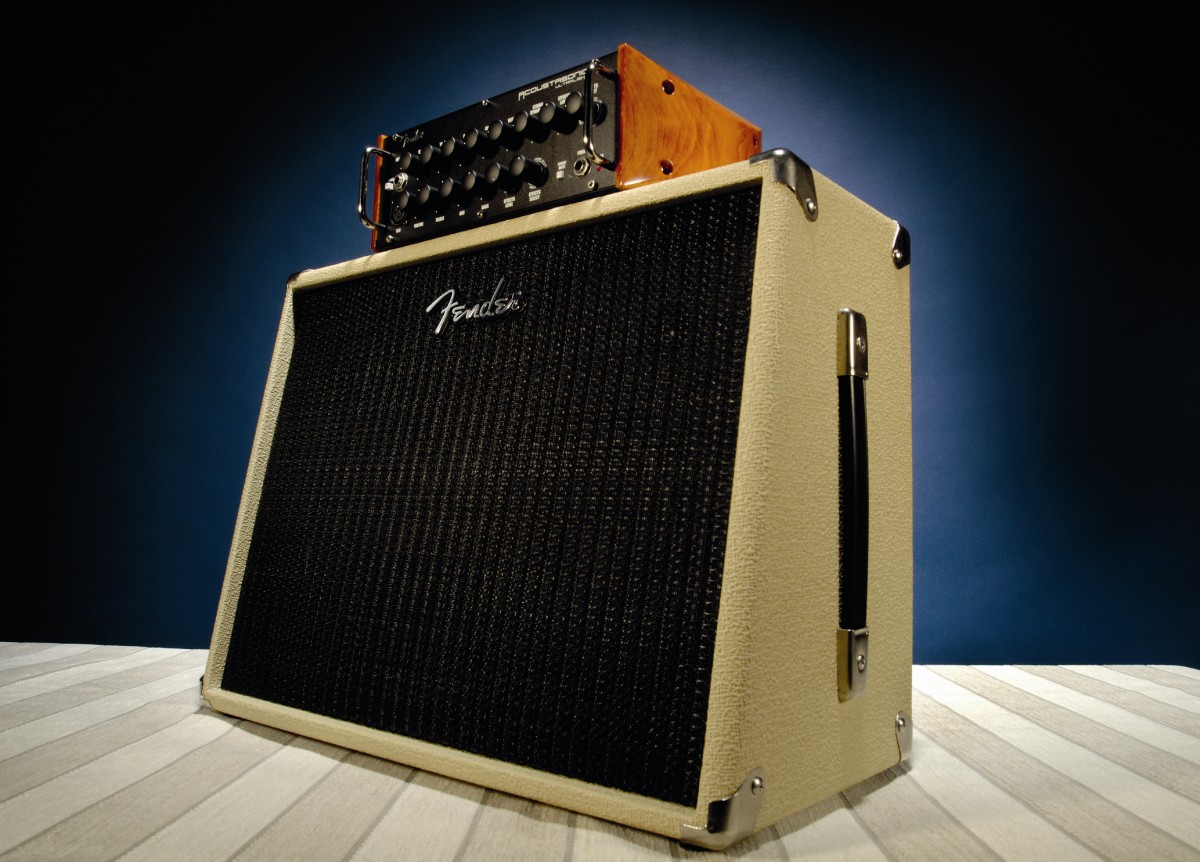MusicRadar Verdict
As a partnership, the Acoustasonic Ultralight system's smooth and sophisticated sonic performance is very impressive in both its quality and its sheer loudness, although you could expect more features and greater interconnectivity at this price.
Pros
- +
Tasteful design. Reassuringly solid construction. Smooth, lush sound with impressive stereo effects.
Cons
- -
No effects loop. Very limited line in/out options. No input gain controls.
MusicRadar's got your back
The latest addition to the Acoustasonic fold also heralds Fender's new Ultralight concept, combining a compact but powerful amp head with a matching lightweight speaker enclosure to offer a stylish, portable package.
Rather than a plain, functional box, the Ultralight amp head stylishly blends a matt black anodised aluminium extrusion chassis with gloss-finished maple side panels and top trim strips. Front and back panels are metal, too, with a tough, slightly textured finish.
Durability and functionality
Despite resembling a piece of posh hi-fi gear, its construction is tank-like. Okay, so there's nothing in the way of corner protection, and the four screw-on rubber feet are relatively titchy, but Fender supplies you with a fitted and padded shoulder bag for transit, and those feet are designed to sit in the docking recesses on top of the Ultralight speaker.
Chrome roll cage-style bars on either side of the front panel protect the knobs if the amp falls on its front. Also, considering this stereo amp's power and features, it's surprisingly lightweight.
The control panel display is logical and immediately intelligible. It's a bit cramped, but those relatively chunky metal knobs look and feel classy, and the pots twist with super-smooth damped rotation, while the effects selector clicks round positively.
With all-metal jack sockets, Neutrik XLR sockets with gold-plated terminals, and Switchcraft HPC speaker output sockets (compatible with Neutrik's industry-standard Speakon locking connection system), the inputs and outputs are durable and top quality.
Fender has chosen to offer just a single volume control for each channel, therefore omitting an input gain control and clip meter.
Want all the hottest music and gear news, reviews, deals, features and more, direct to your inbox? Sign up here.
While the instrument channel's three-band EQ, notch filter and phase switch are standard fare, all Acoustasonic amps benefit from Fender's patented String Dynamics control.
This is a compressor that tames harsh-sounding piezo pickup treble distortion that occurs when you attack the strings heavily.
It selectively compresses the main frequency at which this distortion occurs (about 6.3kHz), but is designed to only catch loud string attack peaks, leaving softly played notes unaffected.
15V phantom power is constantly available at the mic channel's XLR input, which most onboard mini-electret mics will require, and is ignored by balanced dynamic mics. Each channel is equipped with its own effects section.
Both have generally the same 16 stereo digital effects, but sensibly, the mic channel favours two extra reverb settings over other, more experimental effects.
Interconnection options are limited, with only a mono XLR master DI out - albeit with a ground lift and handy level control - and tuner out, but no effects loop or useful line in/out options. But Fender does at least include an on/off footswitch for the onboard effects.
The dry signals from either instrument or mic channel appear at the right and left speaker outputs in dual mono, but the effects create a stereo spread.
You'll need a stereo speaker setup to appreciate this. When you connect a mono speaker cab, though, you simply switch this unit over to mono mode, so your chorus doesn't sound like it's 'half stereo'.
For a perfect match, you can make a neat, secure, single-cable interconnection with the Ultralight stereo speaker.
The right-channel speaker output incorporates a four-conductor, Speakon-compatible socket, wired to route both channels via one output. Fender supplies you with the appropriate pro-standard 560mm (22-inch) four-conductor stereo Neutrik Speakon cable with locking plugs for this purpose.
The left channel socket is a mono two-conductor connection. If you choose to use alternative speaker cabinets, you may find yourself in need of some expensive custom-made interconnect cables.
Sounds
We tried three standard electros through this amp: the new Fender ESA10CE with Fishman's Ellipse VT system; an Avalon AS201CE with a Fishman Prefix Plus system; and a Maton EBG808CL with its own under-saddle piezo pickup system.
Plugged in, these electros usually range from bass-sensitive (Avalon) to crisp (Maton), but this amp/speaker partnership manages to selectively extract an equally impressive performance from each, offering exactly what you need to tweak them to near perfection.
Even with the amp set flat (no EQ, notch or string dynamics), you can hear an impressively broad, lush, smooth sound, with the speaker's twin tweeters producing a perfectly clear yet particularly palatable and sweet treble response.
The twin bass/midrange drivers deliver the rest of the sound spectrum in a satisfyingly rich, room-filling manner.
Typically, though, as you turn up, this system's well-rounded bass needs a little notch and EQ to stop it setting the guitars off.
However, once tweaked, we got exceptional clarity, definition and balance from each guitar we tried, and with plenty of power to hand - there's not a hint of strain in the sound.
If you play with a plectrum and tend to dig in hard, you'll definitely appreciate the amp's String Dynamics feature, which effectively prunes that buzzy ping that accompanies each pluck of the strings.
You have to be careful not to totally stifle your string attack, though. Of course, this system's stereo spread means that the chorus and reverb effects sound wide and lush.
Digital delay on an acoustic can sound too pingy, but here we get subtly softened repeats, which is a particularly nice touch. With its full array of independent controls and effects, the mic channel is ideal for either vocals or an onboard electret mini-mic, and this system delivers equally impressive results from mic sources.
